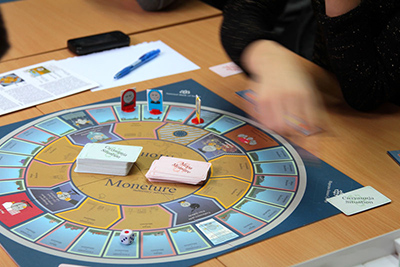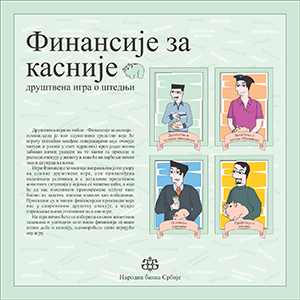Through financial education, the NBS seeks to provide additional information to students regarding operations and functions of a central bank and its monetary policy objectives and instruments. In addition to special programmes, there are guided tours of the standing and themed exhibitions in the building at 12 Kralja Petra Street.
Students can enter the world of creating and implementing a country’s monetary policy by playing the interesting board game Moneture.
This board game was developed by the National Bank of Serbia to familiarise both the professional community and the general public with the way monetary policy is conducted. The game introduces the players to the world of monetary policy in an amusing, imaginative and exciting way, guiding them through the principles of its creation and implementation in line with the challenges it faces daily.
Using a board game to explain how monetary policy is implemented, notably the concept of inflation (its determinants and movements), is a novel form of financial education that the National Bank of Serbia is carrying out according to its corporate social values and objectives.
Moneture is a board game used to present the National Bank of Serbia’s activities in controlling inflation, by creating and implementing monetary policy when faced with specific situations and effects.
No prior knowledge of economics is required to play Moneture, only the willingness to learn, through play and competition, how the monetary system operates.

A player takes on the role of the Governor to face real-life situations our monetary system can encounter, and is challenged to choose adequate measures the central bank would implement to change the situation. The player wins or loses points by taking measures to maintain inflation within the desired target. The scores are the primary indicator of success: inflation rate, value of the dinar and citizens’ trust. Also, to gain membership of the European Monetary System, the player has to meet three requirements (price stability, financial stability and independence of the central bank). The winner is the first player to complete all given tasks and reach the end of the inner circle of the board – average EU inflation.
The game is intended for students of secondary schools of economics, faculties of economics and other faculties teaching banking and finance, employees of the National Bank of Serbia and all those wishing to learn more about monetary policy. Printed both in English and Serbian, Moneture is available to employees of other central banks and the National Bank of Serbia’s guests and colleagues.

The workshop stages a detailed simulation of everyday life situations and in a fun and educational manner encourages young players to learn about income and expenses that await them in the grown-up world. It takes them on a journey through four stages in life: childhood and early education, higher education and employment, starting a family and career, and retirement.
It also clarifies numerous financial products, the method of electronic payment and the significance of financial literacy for a sound budget. The aim of the workshop is to teach participants to cope with life duties and challenges optimally and to save as much as possible for old age and pensions.
The interactive educational programme “Counterfeits” is a short journey through the history of counterfeit coins and paper money, with a special emphasis on counterfeit money in our territory, from the time of King Milutin to date, a detailed presentation of security elements on dinar, euro and US dollar banknotes and the features of their counterfeits. A special presentation is shown to familiarise participants with contemporary security elements of new euro and US dollar banknotes series. In addition, participants will learn about the right way to proceed when encountering suspect counterfeits, as well as pre-emptive activities and proper conduct when buying foreign currency. The one-hour programme enables participants to see examples of dangerous counterfeit dinar and euro banknotes, as well as to apply the acquired knowledge by verifying the authenticity of the three tenders using four basic tests, a UV lamp and a metal detector.
“Monetary History of Serbia” is a lecture designed as a journey through time, from pre-monetary means of payment, through all coins and paper money in our history, to the circulating dinar banknotes that are today used as a legal tender. The one-hour lecture includes a visual presentation of selected coins and banknotes. This is a concise way for university students, as well as high school seniors, to learn about the history of Serbia given that money is a powerful and truthful testimony of incredibly interesting events on the historical stage of Serbia and Serbs who have changed the world.
Educational programme “Money of the Nemanjić Dynasty” designed by the NBS’s Exhibitions and Education Unit is the product of several years of preparation and collection of materials and consists of an eponymous presentation and a 45-minute lecture. The presentation features coin images of members of the holy line of the dynasty, as well as the pictures of rulers in the form of frescoes, coupled with short textual descriptions of coins, while fragments of pages from Miroslav’s Gospel are visible in the background. Thanks to a holistic insight into the coins of this period, the presentation ends with an addendum covering the coins of King Uroš’s co-rulers. As slides in the presentation replace one another, the NBS educator provides detailed explanations, giving high school and university students plenty of information on this topic. In a creative way and using fun facts, “Money of the Dynasty” programme takes students back to the time of the first Serbian money, showing them an abundance of diverse motifs on money, and the importance of its luminaries, members of the Nemanjić dynasty.
Lectures are organised for students by managers of professional organisational units of the National Bank of Serbia on topics the students show interest in.